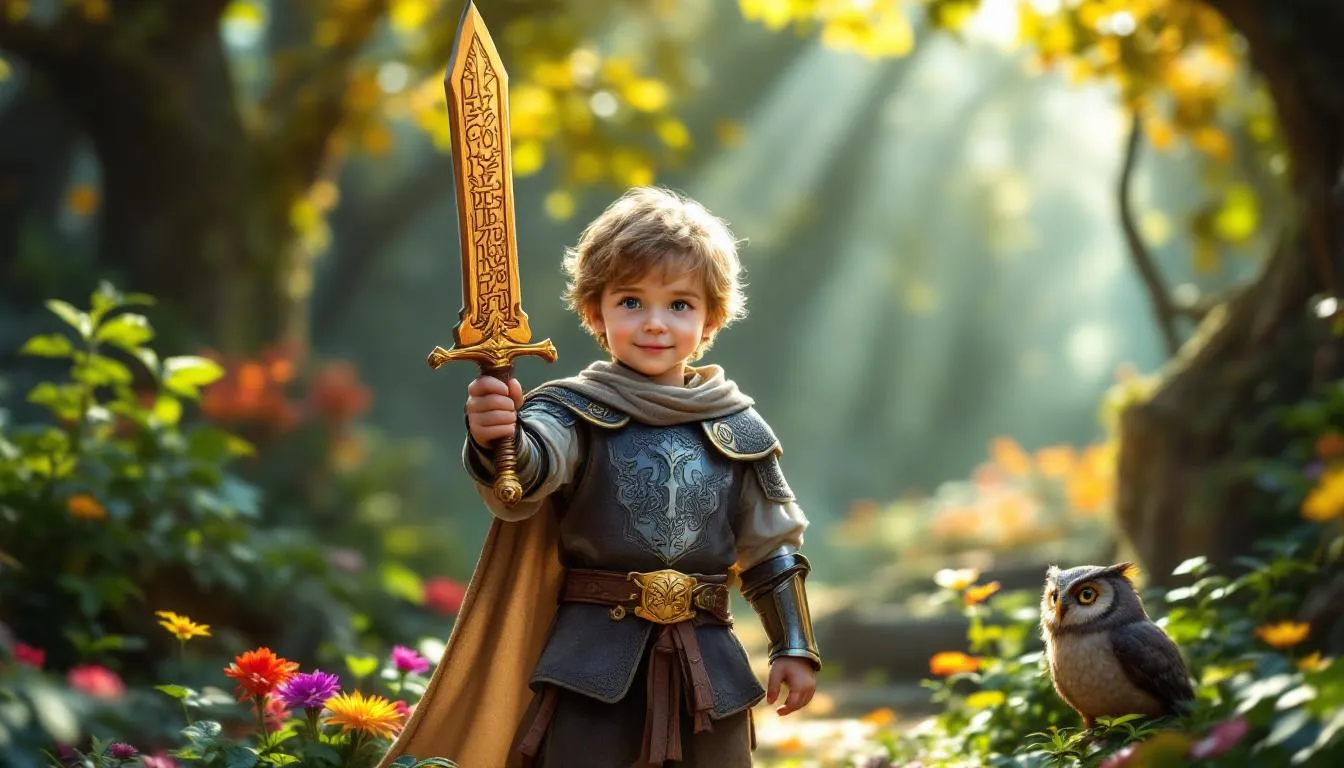In a world where superheroes often wear capes and fly, medieval heroes wielding swords offer a captivating alternative. These tales, rich with noble quests and legendary battles, ignite a child’s imagination while subtly teaching history and martial arts.
Table of Contents
Quick Answer
Exploring medieval heroes and swords inspires kids by combining adventure with educational insights into history and combat skills.
Now, let’s journey through the enchanted realm of these historical figures and their legendary exploits.
Who Were the Influential Medieval Heroes?
When I think about medieval heroes, my mind drifts to tales of courage and valor, reminiscent of the stories I read under my blanket as a kid. One fascinating figure is Finn MacCoul, a giant of a hero in Irish folklore. Imagine a man so strong and clever he built the Giant’s Causeway as stepping stones to Scotland!
Finn’s adventures teach more than strength; they’re rich with lessons on leadership and ingenuity. His legendary deeds, like defeating the fierce Scottish giant Benandonner, highlight problem-solving wit—a quality every parent hopes to instill in their children.
Medieval heroes like Finn MacCoul were cultural icons, shaping the values and ideals of their time by promoting bravery, wisdom, and honor. They served as role models, teaching the importance of standing up for what is right and helping those in need.
Many medieval tales were passed down orally, much like the bedtime stories we tell today. They entertained while teaching societal values, just as we use stories to teach empathy and kindness to our little ones now.
The magic of these stories extends beyond storytelling to the art of swordsmanship, offering kids a unique way to learn about discipline and focus.
How Can Historical European Martial Arts (HEMA) Engage Kids?
When I first discovered Historical European Martial Arts (HEMA), its depth and richness amazed me. Imagine sword fighting as a disciplined practice that combines history, strategy, and athleticism! Introducing kids to HEMA transforms playtime into a thrilling adventure, like stepping into a medieval training ground.
HEMA offers educational benefits beyond physical activity. It’s a hands-on history lesson, where kids learn techniques and tactics used by knights and warriors of the past. This immersive experience helps children appreciate the cultural and historical context of the medieval era, sparking an interest in history that might lead to a newfound passion for learning.
Practicing HEMA develops physical skills and instills discipline, much like traditional martial arts. Here are some key benefits for kids:
- Improved Coordination: Swordplay requires precise movements, enhancing motor skills.
- Increased Fitness: Swinging a sword is a full-body workout, promoting strength and endurance.
- Focus and Discipline: Learning HEMA techniques requires concentration and patience, valuable in any area of life.
- Confidence Building: Mastering new skills boosts self-esteem and encourages kids to tackle new challenges.
As young minds engage with these activities, they glean valuable life lessons from stories and characters that embody medieval heroism’s spirit.
What Lessons Can Kids Learn from Medieval Stories?
Medieval stories captivate me with their recurring themes of bravery, honor, and ethics. These aren’t just remnants of a bygone era; they offer timeless lessons for our children today. Remember the tale of Sir Gawain and the Green Knight? It’s a classic where Gawain displays courage and integrity, even when faced with daunting challenges.
Medieval tales offer more than entertainment; they serve as moral compasses. They teach kids the importance of making ethical choices and standing up for what is right, even when it’s difficult. Reading these stories helps children navigate morality and understand the value of honesty and responsibility.
These narratives also cultivate critical thinking. As kids follow a hero’s journey, they ask questions and consider the consequences of actions, encouraging them to think deeply about motivations and outcomes in both the stories and their own lives.
Here’s how these stories benefit children:
- Courage Under Pressure: Characters face overwhelming odds, teaching kids to be brave and resilient.
- Ethical Decision-Making: Heroes’ moral dilemmas encourage kids to consider right from wrong.
- Empathy and Understanding: By stepping into different characters’ shoes, kids learn empathy.
- Critical Thinking Skills: Analyzing plot and character motivations sharpens analytical skills.
Reflecting on these stories’ power, I think about tangible ways to bring these lessons into our children’s lives, such as through the art of medieval swordsmanship, where they can embody the heroes they admire.
How to Introduce Kids to Medieval Swordsmanship?
When I introduced my kids to medieval swordsmanship, I aimed to make it fun and safe. The key was finding age-appropriate resources that captured their imagination without overwhelming them. We started with simple wooden swords and foam replicas, perfect for younger children, allowing them to role-play safely.
We also discovered fantastic books and online tutorials designed for kids, featuring colorful illustrations and easy-to-follow instructions that make learning swordplay engaging and educational. For instance, a delightful series combines simple fencing moves with stories of knights and dragons, keeping little ones entertained while they learn.
Safety is paramount in swordsmanship. I ensured a clear space free of obstacles, where the kids could swing their swords without breaking anything—or each other! We established ground rules, like keeping a safe distance and stopping when someone yells “halt.”
For those interested in structured learning, many local HEMA clubs offer beginner classes for kids, providing protective gear like masks and padded jackets. This ensures safe practice and adds a social element, where kids can make friends and learn teamwork.
Exploring swordsmanship naturally led us deeper into the stories and history inspiring these practices, opening the door to a broader appreciation for the medieval world.
How Can Medieval Adventures Promote Historical Knowledge?
Telling my kids stories of medieval adventures ignites their curiosity and wonder. These tales transform history from dates and facts into a vibrant tapestry of quests and conquests. Storytelling is a powerful tool for teaching history, making the past come alive and connecting the historical world to children’s imaginative minds.
Medieval adventures are not just about knights in shining armor; they are gateways to understanding the culture, beliefs, and events that shaped our world. When I narrate the Battle of Hastings, I’m not just recounting a battle; I’m immersing my children in the atmosphere of 1066, helping them grasp the Norman Conquest’s significance.
To make historical events relatable, I use engaging methods that resonate with kids. Interactive activities like creating DIY medieval shields or role-playing as famous historical figures turn history lessons into adventures. I’ve even organized treasure hunts based on historical events, where each clue teaches a fact about the past.
Visual aids, like animated documentaries or historical fiction books tailored for children, help them visualize the era, making abstract concepts more concrete and memorable. By weaving history into their play and learning, I hope to inspire a lifelong curiosity about the world.
Fostering this connection to history through medieval adventures enriches their knowledge and shapes their perspective on the present and future.
And for those looking to make their child truly part of the adventure, KidTeller offers a unique service. Imagine a personalized storybook where your child is the hero! Just upload a photo, and they’ll generate a custom book filled with adventures made especially for your toddler or young child – magical, memorable, and uniquely theirs.
Key Takeaways
- Medieval heroes and their adventures spark curiosity and teach kids about history and cultural values.
- Historical European Martial Arts (HEMA) combines fun with learning, enhancing physical fitness and mental discipline.
- Tales from medieval times offer timeless moral lessons, nurturing empathy, bravery, and critical thinking in children.
- Introduce children to these concepts with age-appropriate resources and activities, like storytelling and safe swordplay.
By integrating these elements into your child’s life, you can inspire a love for history and cultivate a foundation for lifelong learning and exploration.







